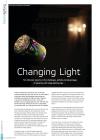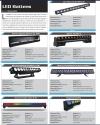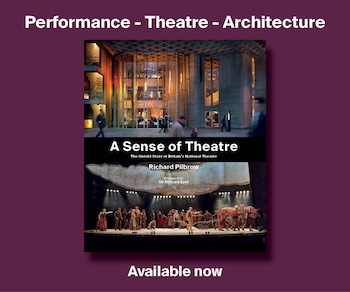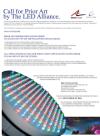PAGE UNDER CONSTRUCTION
Author: Jon Primrose. Last updated 31 December 2024
See the bottom of the page for more about the History of LED lighting.
What are LEDs?
An L.E.D. is an electronic component (full name Light Emitting Diode) which produces light when electric current passes through it in one direction.
In recent years, the efficiency of LEDs has risen and the cost has dropped, meaning that it’s possible to use LED lighting in an entire rig without losing significant brightness.

LSI: Classic Gear - Visible Light LEDs (November 2012)
[External Website]
From Lighting & Sound International

Les Mis - Lights in their Multitudes (July 2020)
[External Website]
From Lighting & Sound International
What kind of fixtures are available with LEDs?
There are a wide range of types of LED fixture now available, which are beginning to mirror the qualities of incandescent stage lights.
eLumen8 Tri pixel batten
Flood / Battens
LED floods are usually single colour, but available with colour mixing, in various different sizes for applications as varied as outdoor security lighting through to specialised lighting for stage cycloramas. A collection of LED sources in a row is known as an LED Batten.
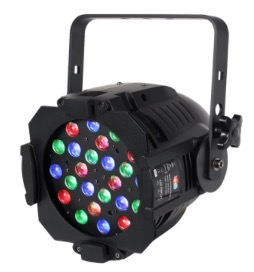
LEDJ RGB Par
PAR
These are the most common, as they produce a wash of light similar to that from a Parcan or a Fresnel.
Usually RGB, but sometimes RGBW or RGBAW (red, green, blue, amber, white) for the best range of colours.
The beam size (like a Parcan) is not adjustable on most, although there are zoom versions available.
Profile
Only widely available in the last few years, companies such as ETC are leading the way in LED technology which beats the equivalent incandescent fitting, but with full, subtle, theatre-appropriate colour mixing. Although the products are expensive, again, the prices are dropping, and becoming more affordable. Most specialist suppliers will be able to demonstrate the products before you buy – it’s important to see what you’re getting, as the quality varies considerably if you choose cheaper products.
Why do LEDs have electronics circuits controlling them?
LED light sources require driver circuitry to provide the stable voltage and current they need to operate. The electronics also receive the DMX signal from the lighting control desk, and also helps with smooth colour mixing and reduction of flicker (so that LED light sources look good on video as well as in person).
For this reason, most LED fixtures cannot be connected to a standard lighting dimmer. They require a constant power feed.
Having said that, some recent fixtures CAN be dimmed using a standard (relatively modern) stage lighting dimmer – these are not colour-mixing LEDs however, and provide a way to convert an entire lighting rig to LED white light sources with no change in the cabling or other infrastructure.
How do you use LEDs in a stage lighting rig?
- Power Supply
LED fixtures designed for entertainment use are not the same as regular stage lights.
Most LED fixtures contain processors and electronics to control the light, so they must not be connected to a dimmer. The same applies for any moving light. They require a clean constant undimmed power source.
Some dimmer racks have a physical switch to ‘bypass’ the dimmer, and provide the undimmed ‘hard power’ the fixtures need. But most dimmer racks will damage the power supply of moving lights or LED fixtures if you try to power them from the dimmer, even if the dimmer is set to 100% output.
Modern stage lighting installations include the provision of power sockets on the lighting rig which are not via the dimming system – these can be used for data projectors, LED fixtures, moving lights etc. If your installation does not have such power supplies available, you may be able to unplug the feed to a particular lantern from the dimmer rack, and use an adaptor to enable it to be plugged direct into a power socket. In the UK, many venues have 13A to 15A adaptors (square pin plug to round pin socket) which are used for this purpose. Because the 13A plug has a fuse in it, this method is completely safe. The only issue is remembering to turn them off after each lighting session (and remembering to turn them back on again before the show!). To minimise power wastage, the correct sustainable practice is to turn them on only when needed, and power them off if they’re not needed again for a few hours. - Control Signal
A control signal must also be connected to each LED fixture, which comes direct from the lighting desk, and is known as DMX512.
Some LED fittings are single colour, but most contain LEDs which can produce Red, Green and Blue light independently. These LED fixtures are known as RGB, and enable a wide range of colours to be produced on stage by mixing them together in varying amounts. An RGB fixture requires 3 DMX512 channels to control it, one channel for each colour.
An even wider range of colours can be produced using RGBAW LED fixtures (Red, Green, Blue, Amber, White), including more subtle pastel shades. These require 5 DMX512 channels.
Each LED fixture has an ‘address’ which can be set on the fixture, and tells each unit what control channels from the lighting desk to respond to.
For example, in a small drama studio with 24 dimmers, the control desk needs 24 channels to control them. Adding LED fixtures into the studio increases the number of control channels required. Adding four RGB LED fixtures will add 4 x 3 = 12 channels, if they’re all to be controlled separately. So, in this example, the channels are allocated as follows:
| Control Channel | Function |
| 1 through to 24 | Dimmers 1 to 24 |
| 25 | LED #1 – Red |
| 26 | LED #1 – Green |
| 27 | LED #1 – Blue |
| 28 | LED #2 – Red |
| 29 | LED #2 – Green |
| 30 | LED #2 – Blue |
| and so on |
In this case, LED #1 would be set to start address 25 and LED #2 would be addressed to 28.
If you want all of the LEDs in the rig to respond in the same colour at the same time, you can set them all to the same start address (e.g. channel 25).
The lighting desk channels can then be mixed to produce the required colours.
Modern computerised lighting desks make life easier by enabling you to control all of the colours by only selecting the LED fixture once.
Using LEDs with modern computerised lighting desks
On modern desks, LEDs are treated the same as any other fixtures. This term includes moving lights, LEDs and any other equipment which can be controlled using DMX512 control signal from the lighting desk. Instead of worrying about which channel on the desk to use for red, which for green etc, a modern desk allocates a channel number to the LED instrument, and uses the DMX channels in the background, without you having to worry about them. The same DMX channels are used up, but the soft patch inside the control desk takes care of them.
When you select each LED fixture (or group of LED fixtures), the desk software allows you to select the required colour from a palette, or from a list approximating the gel ranges of companies such as Rosco or Lee Filters.
Using the same example as above, the control desk becomes easier to use, and the work is done by the software.
| Control Channel | Function |
| 1 through to 24 | Dimmers 1 to 24 (using DMX channels 1-24) |
| 25 | LED fixture #1 (using DMX channels 25-27) |
| 26 | LED fixture #2 (using DMX channels 28-30) |
It can be seen that the control channel that you use on the desk may or may not also be the DMX channel that the fixture or equipment is addressed to.
Why use LEDs? They cost a lot more than regular instruments.
LEDs are far more energy efficient. An LED flood may use only 30 Watts of power, but produce the same amount of light as a 300 Watt traditional floodlight. As the industry becomes more aware of the need to use sustainable practices, LEDs are becoming essential.
LEDs enable an (almost) infinite variety of colours to be produced on stage without having to rig lots of traditional filament lanterns with gel in front of them. This is a vast saving in time and effort. The colours can be adjusted without climbing a ladder.
What is the difference between the cheap ones and the really expensive ones?
- Flicker
Incandescent (filament) light bulbs have a relatively slow heat up / cool down time. The light fades (over a fraction of a second) when you cut the power. However, with an LED, the light cuts off completely and instantly as soon as the power is removed.
LED lights at 100% do not flicker noticeably, but as they are dimmed electronically, the flicker is visible to a video camera (if not to the naked eye). If an LED colour (in a cheaper fitting) is kept at a low level, the flicker will be very noticeable on video recordings.
The higher the refresh rate of the LED, the faster (and less visible) the flicker. The flicker rate is measured in Hertz (Hz) – cycles per second. So, a 400Hz refresh rate means the LEDs flicker 400 times per second.
COMING SOON – Video demonstration of LED Parcans with 400Hz refresh rate.
More expensive LED units have very high refresh rates which do not show up on video, regardless of the intensity. - Smooth Dimming
As the LED gets dimmer and dimmer, there comes a point when it just cuts out (switches off). With cheaper fittings, this cut off is more pronounced and more visible.
COMING SOON – Video demonstration of LED dimming. - Brightness
- Colour Rendering
There may be differences in how different instruments of a particular model react to an identical DMX value, meaning the colours may not match between instruments. - Reliability
As the cost comes down, the chance of the electronic components (particularly the power supply) in the unit rises. You get what you pay for – if you buy a cheap product, assume it will not last very long.
Why does everyone not use them all the time?
- Cost
An LED instrument costs a lot more than one using standard filament bulbs. - Colour Rendering
LED light can appear cold and harsh – it lacks the warmth and subtlety of tungsten lamps. Although this is improving dramatically as technology improves. - Controllability
Although the LED fitting is connected to a control signal from the lighting desk, the electronics in many cheaper LED fittings do not allow them to dim completely smoothly, resulting in a ‘stepped’ dim, rather than a smooth seamless dim. - Noise
Some LED units have fans to keep the electronics cool, and these add to the ‘noise floor’ of a studio theatre space.
MORE INFORMATION AND ILLUSTRATIONS COMING SOON
Retrofitting LED Light Source into Theatre Lanterns
At the moment there are no direct replacements for specialist theatre lamps to convert existing lanterns to LED.
History
The first stage profile lantern with an LED light source was the Robert Juliat Aledin 630 in 2010.
See articles below for more about the Color Kinetics patent challenges.

LSI: LED Litigation: Super Vision (November 2004)
[External Website]
From Lighting & Sound International
MORE COMING SOON
Keywords: Led lights, Lighting with LEDS, Using LEDS for Lighting, led lights have electrical boards on back them




